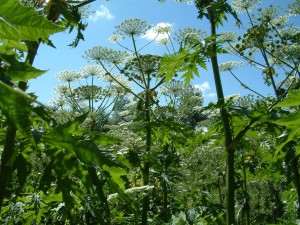Tread carefully with Giant Hogweed urges trade body
21/07/2015
National trade body The Property Care Association is urging local authorities, statutory bodies, landowners and property professionals to treat Giant Hogweed with caution.
In recent weeks the invasive weed has been in the media spotlight, with incidents of injuries being reported, including to children.
The numbers of injuries could be set to increase as children roam affected areas in the summer holidays. There’s also a risk of injury to those tasked with removing the plant, unless correct safety measures are introduced.
Giant Hogweed sap is extremely toxic to the skin in sunlight, making it a serious and significant danger to public health.
Contact with any part of the plant, followed by exposure to sunlight, can cause severe blistering to the skin and discomfort, the latter possibly recurring over a number of years.
Stephen Hodgson, Chief Executive of the PCA, said: “Giant Hogweed is widespread and the problems it can cause are certainly not insignificant.
“Children in particular are going to come across it in the summer holiday period.
“The general public, as well as local authorities, statutory agencies and landowners on whose property people can come into contact with the plant need to be aware of the risks.
“Giant Hogweed needs to be controlled and managed professionally.”
Further information on the plant is now available in the form of a Guidance Note from The Property Care Association (PCA).
Chairman of the PCA’s specialist Invasive Weed Control Group, Professor Max Wade, and fellow senior ecologist Dr Mark Fennell, have shared their expertise to produce detailed information covering this species of non-native plant.
History and identification, the impact of Giant Hogweed, and details of control methods are all discussed – and further guidance is also offered on the health risks associated with this invasive weed.
The guidance note can be viewed at https://www.property-care.org/wp-content/uploads/2014/12/Guidance-Note-Giant-Hogweed.pdf
Professor Max Wade said: “There are a number of factors operating together as to why the health issues of Giant Hogweed have increased recently.
“There is greater awareness of this invasive non-native plant, which is still spreading, and hence is found in more locations.
“Given the recent warm weather, people including children have, as a result, been in contact with the plant when in the sunshine.
“As the chemical in Giant Hogweed, a furanocoumarin, needs bright light to react with the skin and cause blistering and other health problems, this is the type of environment where problems can ensure.”
Giant Hogweed, along with the more widely known Japanese Knotweed, is increasingly coming under the spotlight of land and property professionals.
This is due in part to the reformed Anti-social Behaviour, Crime and Policing Act 2014, and associated Community Protection Notices, which could be issued to necessitate landowners to deal with Japanese knotweed.
This could see fines of up to £20,000 imposed for companies failing to tackle the problem. Individuals would also be forced to comply too, or face a fine of up to £2,500.
Furthermore, as well as the ASBO legislation, new EU regulations have been introduced which could result in fines of thousands of pounds and prosecution if invasive plants such as these are not managed appropriately and in a timely fashion.
The EU regulations, which came into effect in January, will empower government agencies to issue Control Orders that necessitate the removal of high risk invasive weed species from specified areas, which could potentially include derelict sites, public land, construction sites and neighbouring properties.
The guidance note is one of seven new documents being produced this year by the PCA, which tackle a wide-range of issues relating to the invasive weed control sector.
They support a range of initiatives already in place, including a code of practice and an industry-recognised training programme for its professional members and those interested in the biology and control of the plant.
In September the PCA is holding a specialised conference, dedicated to the subject of non-native invasive plants including Giant Hogweed.
‘Understanding Invasive Weeds: Japanese Knotweed, Fact and Fiction’ takes place on 23 September at The Vale Resort, Hensol, Cardiff.
It is the first conference held by the PCA’s specialist Invasive Weed Control Group
As well as seeking to promote a level-headed and evidence based approach to Japanese Knotweed and Giant Hogweed, the conference will also provide information on Himalayan Balsam.
The conference is of interest to a wide-range of professionals, reflecting the impact invasive weeds have throughout the UK.
These include local authorities, statutory agencies, the rail, road and port industries, lawyers, utility companies, estate managers, house builders and developers, landlords, estate agents, housing associations, property agents, academia, surveyors and asset managers.
Bookings can be made at https://www.property-care.org/invasive-weed-control-group-conference-understanding-invasive-weeds-japanese-knotweed-fact-and-fiction/
Professor Wade has also wrote a book with colleague Olaf Booy, “Giant Hogweed Management In The United Kingdom, which is available from nhbs online book sales at https://www.nhbs.com/title/152087/giant-hogweed-management-in-the-united-kingdom.




